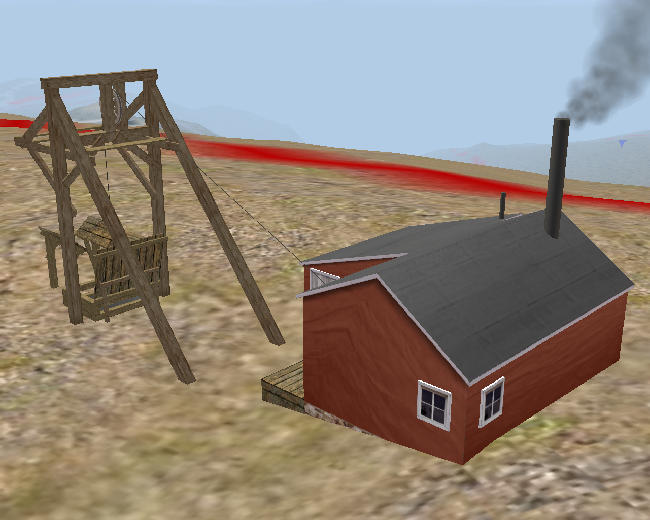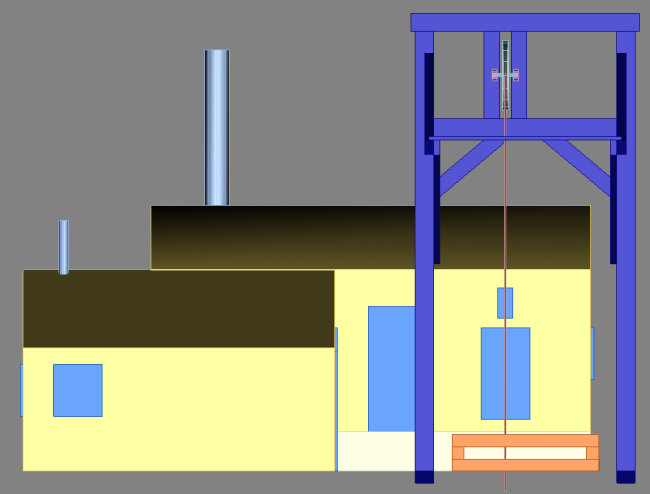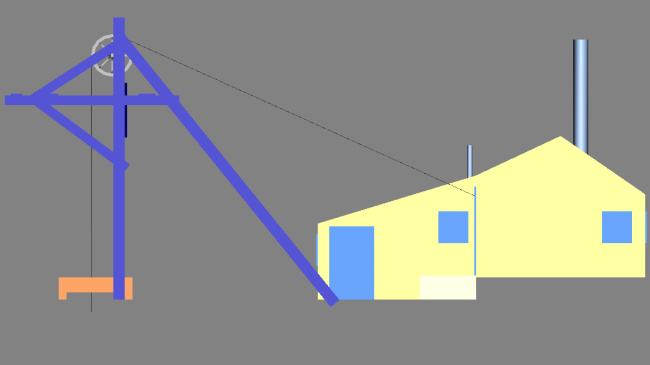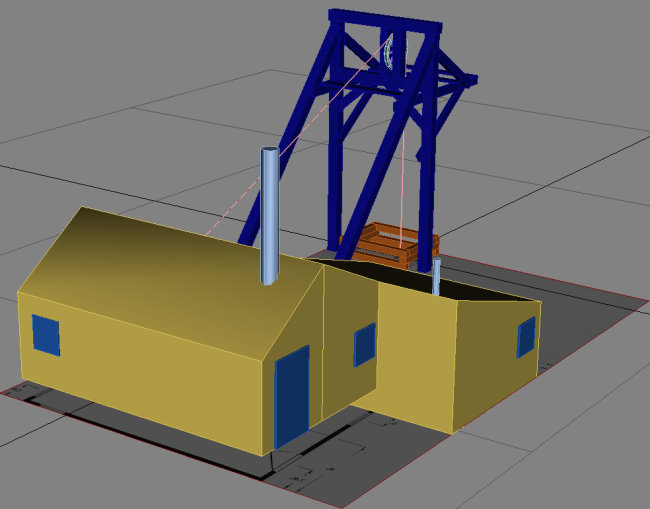31.05.2005
Model can now be found and downloaded from the Trainz Download Station - Look up KUID2:77573:25011:1. Or use my main Downloads page (TRS2004 or newer only) for a link to the file at the Trainz Download Station.
Or, you can just click here on this Direct Link, need Download Helper and installs direct into Trainz, or Content Manager if TRS2006 or newer.
18.10.2004
It took me actually much longer then I had in mind when I started this on Thursday, but the end result I think was well worth the effort! Especially when I tried to use something called LOD (Level Of Details) to try reduce the burden on the computer when not close to model.
I struggled with this for 12 hours, but that includes about 7 hour of sleep and 2 hours doing other stuff - including searching the Trainz forum looking for an answer - before I actually made it work inside of Trainz! That was frustrating times, I've copied the text straight from Auran's example files (which proved today to be the answer/problem) and no way would it show up!
When going all the way back to January this year on the forum I finely found the solution, there was this guy asking for help on more or less same problem, one of his problems was that he also had copied text from Auran's example, and therefore the character " where different then if written directly in notepad - when reading that, and then test it, wow, there my mine was, finely!!
I have two levels of LOD, one with "just" 807 polygons, and one with the full detailed look at 1113 polygons!! Being that this mine actually not is very visible from any tracks at all inside my Cripple Creek map - and not even existing in my time frame - I think I will try make an even lower version after I have had lunch today.
Update, lunch is over long time ago, I ended up with 3 level of LOD, the lowest being 398 polygons (took out the sheave wheel, underside roof and so on) - and have to uploaded to the preview site on the DLS at Auran.
Within a day or two I guess it will be available, and then I will update this page with a link - and most probably move page to another place on this website, one for actually finished models (which I still don't have of Cripple Creek stuff).
For now, this is the latest pictures I have to show:

The model as seen inside of Trainz, near top of Bull Hill, but exact position is unfortunately unknown.

By taking a guess I put it down a little behind (north) and left (west) of the American Eagle Mine.

Which would put the American Eagle Mine a little to the left for this picture, again, it's just a guess...
16.10.2004
Pictures for tonight:
.jpg)
This is how it looked in gmax right after I finished making the basic mesh. The polycount was very high when this screen was taken, but that is because I used a orecar (2200 polygons) I'm making, and therefore this scene had a whopping total of 3400 polygons!
.jpg)
This was before I started to trim unseen polygons and add a roof. And, removing the orecar which itself is about 2200 polygons (which I need to do more work on, so that will change). I left out a couple of small details, and made the rest with full sizes.
.jpg)
This is how the fully textured mine looks in TOE, polygons is now "just" 1064 - I took out orecar but the headframe and sheave wheel adds quite a deal to the total polycount. I still need to tweak textures, and make them similar in colors & size - but for now, I like it.
Some more info about this mine has been found. It was located on the west slope of Bull Hill, east of the town Cripple Creek it self, almost in the backyard of the American Eagle I read somewhere. ![]()
Got organized in 1894 as the Favorite Gold Mining Company(1.), and had by 1900 dug a 143 foot deep primary shaft called "Newman". They also had a secondary shaft some 300 feet to the east at a depth of 75 foot.
Both this shafts where dry and with no dangerous gases to make mining difficult. At the 115 foot level of the "Newman" shaft there where drifts running north and south along a 4,5 foot wide Basalt vein. This vein produced 3 grades of ore.
In 1900 was the mine sold to W.S. Stratton - most probably because it's closeness to the American Eagle and within the area he was interested for with his "bowl of gold" theory. What happen after this I don't know, but Gary do mention in his article(2.) that his drawings are based on several old pictures taken around 1905 - so far I have found none by looking around Internet. Still have left to go over my own book collection that I one day soon better start cataloguing pictures in so I don't have to constantly browse through them looking for that one picture I need there and then..
Not being a big producer and having a deep mine, the Favorite didn't need a big/extensive headframe. They used a ore bucket which was about the size of an iron barrel and could be used for both lowering men and materials and to hoist up ore, waste and water if encountered. Bucket's side where curved to prevent it catching the sides of the shaft.
How all this worked according to the article was quite simple. Top of shaft is/was called a "shaft collar" and the man standing there was/is called a "top lander". So, when the bucket cleared the shaft he slammed the trapdoor (a lid covering the shaft) to prevent rocks from the ore bucket to get loose and go back into the hole and hitting someone down there
After doing that he climbed the stairs up to a platform where he hooked a block and tackle to the bottom eye of the bucket. The hoist operator then slowly lowered the ore bucket while the "top lander" pulled on the block and tackle swinging the bucket away from the shaft towards the platform where he was standing.
By doing this the ore bucket would tip over and the ore/waste inside of it would then dump into a waiting little ore car below the loading platform. Then the hoist operator would hoist the bucket up again, the block and tackle would have been removed, the "top lander" would have gone down from the platform, and opened the trapdoor and bucket would go down the hole again.
Meanwhile, another man, or maybe even the "top lander" after open trapdoor, would take the now full ore car (most likely a 18" car) to either the dump or a orebin close by for storage until it was full enough to warrant a further trip with some other transport - either a train or animal train - to the mill.
All this would make for a wonderful animation inside of Trainz, but alas, my skills are not even close to what they need to be to pull this off... ![]()
15.10.2004
The Favorite Mine is my fourth attempt of buildings/structures of the Cripple Creek District. Reason this time is an article & drawings in the NG&SLG Jan-Feb 1992 (p56-59) magazine. Being that the drawing is copyright 1991 by Gary M. Whooler of (then at least) Timberline Scale Drawings I can't show either them or the article without permission, which I haven't sought after so... ![]()
But, it's a nice little article, some info in there I will put in here later together with other bit's and pieces, but for, if you are interested, and would like to see that article, try to locate this magazine for instance on ebay as I see them there all the time
And, it's being a small mine means it should be quite easy and fast to make this (when I was younger, I actually made part of this mine as an H0 model) - or so I though yesterday when I started it... ![]()
Today I'm still working with putting in the basics, buildings are done, so is head frame, and the shaft collar except the lid that protected the miners below from getting a stone or three in the head when the bucket is unloaded at the top. I also haven't made the actually unloading parts, or the ore bucket - but it comes along.
I just wondered off gmax a little and started writing/making this page, and to collect some more info about this mine and the company(1.) behind it. But, I will get back to work again, just put in a couple of screenshots from gmax and the basic model. ![]()
Today's pictures:

Fig.1 - Left side of the mine in so called wireframe.

Fig.2 - Front of mine.

Fig.3 - Right side, just with the basic colors gmax make. I felt quite proud of this model when I saw what I could create.

Fig.4 - This is the backside, seen as perspective.